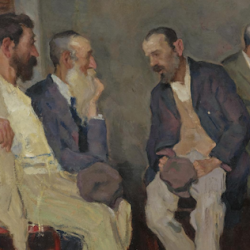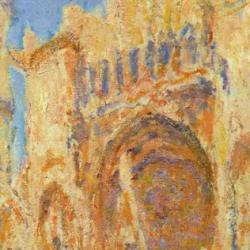If the infinite God is to be present within a finite creation, writes David Bentley Hart (Beauty of the Infinite, 204), “the finite must . . . become ever more open, ever greater and more capacious . . . ; and creaturely mutability allows for this.”
Hart is writing about Gregory of Nyssa, and adds that God’s presence to creatures is “ineffable for Gregory,” such that “‘presence’ is probably as much as need be said: the parousia of what belongs to the divine ousia. This is merely the language of the ontological difference: the soul’s relation to God – the relation of the contingent to the infinite, of becoming to He Who Is – is not the relation between two things, ‘this’ and ‘that’; and there need never be for the creature a hard and fast division between the ontological and existential: created nature, ever changing, is what happens to it, and so is ever more divine because the Holy Spirit acts upon it – fashioning the mutable fabric of divine being into the motile beauty of the divine image.”
A mouthful and more, as so often in Hart, but my interest here is in this passing comment, and elaborating footnote: “whether the fourteenth-century Palamite distinction between God’s essence and energies would have found favor with [Gregory] is an open question.” And then, footnoting, “I am not at all convinced that Palamas ever intended to suggest a real distinction between God’s essence and energies; nor am I even confident that the energies should be seen as anything other than sanctifying grace by which the Holy Spirit makes the Trinity really present to creatures. I take the distinction to mean only that God’s transcendence is such that he is free to be the God he is even in the realm of creaturely finitude, without estrangement from himself and without the creature being admitted thus to an unmediated vision of the divine essence.” (Hart cites articles that draw direct connections between the Cappadocians and the Palamite theology, as well as articles that view “Palamitism as an apostasy from Cappadocian thought.”)
This modest account of the essence/energies distinction is attractive (to Western ears), but is Hart right? David Bradshaw (Aristotle East and West, 274-5) at the very least sees significant continuity from the Cappadocians to Palamas, and also stresses the importance of the distinction to Eastern theology: Palamas “to reconceive what have traditionally been regarded as distinct categories – the eternal, necessary divine attributes and contingent, temporal divine activities – as species within a broader genus, that of acts of self-manifestation. It is interesting in this connection that at least some divine attributes, such as truth and righteousness, are spoken of in Scripture as activities to be performed. . . . The East has no concept of God. It views God not as an essence to be grasped intellectually, but as a personal reality known through His acts, and above all by oneself sharing in those acts.”
Bradshaw suggests that the various Enlightenment charges against Christianity would have found a different response, and perhaps would not have arisen at all, in a context dominated by Palamas: “For the East morality is not primarily a matter of conformance to law, nor (in a more Aristotelian vein) of achieving human excellence by acquiring the virtues. It is a matter of coming to know God by sharing in His acts and manifesting His image. It is striking, in this connection, that the long western tradition of lay resistance to the clerical enforcement of morals had no real analogue in the East. One finds nothing like the goliardic poetry or the courtly love movement of theMiddle Ages, much less the studied worldliness of authors such as Boccaccio. No doubt there were many reasons for this difference, but among them was surely the varying extent to which East andWest had succeeded in incorporating the whole person within their conception of the human good” (275-6).














